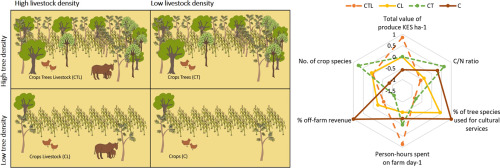当前位置:
X-MOL 学术
›
Agric. Syst.
›
论文详情
Our official English website, www.x-mol.net, welcomes your
feedback! (Note: you will need to create a separate account there.)
The role of trees and livestock in ecosystem service provision and farm priorities on smallholder farms in the Rift Valley, Kenya
Agricultural Systems ( IF 6.1 ) Pub Date : 2020-05-01 , DOI: 10.1016/j.agsy.2020.102815 Ylva Nyberg , Johanna Wetterlind , Mattias Jonsson , Ingrid Öborn
Agricultural Systems ( IF 6.1 ) Pub Date : 2020-05-01 , DOI: 10.1016/j.agsy.2020.102815 Ylva Nyberg , Johanna Wetterlind , Mattias Jonsson , Ingrid Öborn

|
Abstract Human beings are dependent on ecosystems and the services they provide. Some services are currently being overexploited, resulting in degradation and further pressure on already vulnerable people in e.g., sub-Saharan Africa. Long-term and stable delivery of ecosystem services (ES) is suggested to be enhanced by more diversified farming systems that e.g., mix crops with trees and livestock. Despite the amount of research on ES, few previous studies have identified and compared the roles of trees and livestock for ES considering farm priorities within smallholder systems. We studied the role of trees and livestock for ES provision as well as farm priorities for smallholders in Kenya. Twenty smallholder farms (0.2–0.8 ha) were studied for 1 year in a fully factorial design of high or low tree and livestock density systems. Data were collected on indicators for provisioning (crop, tree and livestock production), supporting/regulating (water infiltration, soil organic carbon and nutrients) and cultural (recreation and aesthetics) ESs. In addition, farm priorities were studied, considering nutrient management, on- and off-farm resources, food and consumption, and crop, tree and livestock species diversity. A mix of qualitative (e.g., semi-structured interviews, seasonal calendar) and quantitative (e.g., soil analyses, infiltration tests) methods were used to collect data. This study confirmed roles of trees and livestock for ES and farm priorities, although they in some cases appeared less important than family labour and farm size. Results showed that high tree density was related to higher workload, lower proportions of off-farm revenue as well as higher crop, fruit and tree diversity for the household. Tree or livestock density showed no clear relation to provisioning, supporting or regulating ES. However, cultural services were on average provided more by trees than livestock. Available family labour was positively related to both farm production (provisioning services) and crop, tree and livestock species diversity. The use of manure, compost and mineral fertilisers was overall low, and the application rate per unit area seemed higher on farms with less land which was reflected in higher soil P and Ca concentrations. The challenges of already small and reducing farm sizes need to be targeted seriously in research and development efforts. Also the issue of labour requirement and pathways for mechanization must be addressed to attract a new generation farmers to develop sustainable and profitable farm enterprises providing ES to the farm and the surrounding landscape.
中文翻译:

树木和牲畜在肯尼亚裂谷小农农场的生态系统服务提供和农场优先事项中的作用
摘要 人类依赖于生态系统及其提供的服务。一些服务目前被过度开发,导致退化,并对撒哈拉以南非洲等地区本已脆弱的人群造成进一步压力。建议通过更多样化的耕作系统来加强生态系统服务 (ES) 的长期和稳定提供,例如,将作物与树木和牲畜混合。尽管对 ES 进行了大量研究,但之前的研究很少确定和比较树木和牲畜在考虑小农系统内农场优先级的 ES 中的作用。我们研究了树木和牲畜在提供 ES 方面的作用以及肯尼亚小农的农场优先事项。在高或低树木和牲畜密度系统的全因子设计中对 20 个小农场(0.2-0.8 公顷)进行了为期 1 年的研究。收集了关于供应(作物、树木和牲畜生产)、支持/调节(水渗透、土壤有机碳和养分)和文化(娱乐和美学)生态系统指标的数据。此外,还研究了农场优先事项,考虑了养分管理、农场内外资源、食物和消费以及作物、树木和牲畜物种的多样性。混合使用定性(例如,半结构化访谈、季节性日历)和定量(例如,土壤分析、渗透测试)方法来收集数据。这项研究证实了树木和牲畜对 ES 和农场优先事项的作用,尽管在某些情况下,它们似乎不如家庭劳动力和农场规模重要。结果表明,高树木密度与更高的工作量、更低的非农收入比例以及更高的收成有关,家庭的水果和树木多样性。树木或牲畜密度与提供、支持或调节 ES 没有明显关系。然而,平均而言,树木提供的文化服务多于牲畜。可用的家庭劳动力与农业生产(提供服务)和作物、树木和牲畜物种多样性呈正相关。粪肥、堆肥和矿物肥料的使用总体上较低,在土地较少的农场,单位面积的施用量似乎更高,这体现在土壤 P 和 Ca 浓度较高。研究和开发工作需要认真针对已经很小和缩小农场规模的挑战。
更新日期:2020-05-01
中文翻译:

树木和牲畜在肯尼亚裂谷小农农场的生态系统服务提供和农场优先事项中的作用
摘要 人类依赖于生态系统及其提供的服务。一些服务目前被过度开发,导致退化,并对撒哈拉以南非洲等地区本已脆弱的人群造成进一步压力。建议通过更多样化的耕作系统来加强生态系统服务 (ES) 的长期和稳定提供,例如,将作物与树木和牲畜混合。尽管对 ES 进行了大量研究,但之前的研究很少确定和比较树木和牲畜在考虑小农系统内农场优先级的 ES 中的作用。我们研究了树木和牲畜在提供 ES 方面的作用以及肯尼亚小农的农场优先事项。在高或低树木和牲畜密度系统的全因子设计中对 20 个小农场(0.2-0.8 公顷)进行了为期 1 年的研究。收集了关于供应(作物、树木和牲畜生产)、支持/调节(水渗透、土壤有机碳和养分)和文化(娱乐和美学)生态系统指标的数据。此外,还研究了农场优先事项,考虑了养分管理、农场内外资源、食物和消费以及作物、树木和牲畜物种的多样性。混合使用定性(例如,半结构化访谈、季节性日历)和定量(例如,土壤分析、渗透测试)方法来收集数据。这项研究证实了树木和牲畜对 ES 和农场优先事项的作用,尽管在某些情况下,它们似乎不如家庭劳动力和农场规模重要。结果表明,高树木密度与更高的工作量、更低的非农收入比例以及更高的收成有关,家庭的水果和树木多样性。树木或牲畜密度与提供、支持或调节 ES 没有明显关系。然而,平均而言,树木提供的文化服务多于牲畜。可用的家庭劳动力与农业生产(提供服务)和作物、树木和牲畜物种多样性呈正相关。粪肥、堆肥和矿物肥料的使用总体上较低,在土地较少的农场,单位面积的施用量似乎更高,这体现在土壤 P 和 Ca 浓度较高。研究和开发工作需要认真针对已经很小和缩小农场规模的挑战。











































 京公网安备 11010802027423号
京公网安备 11010802027423号